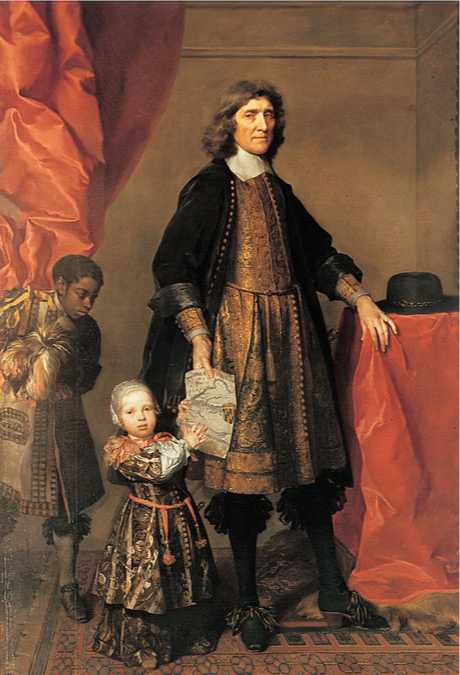The Virginia and New England colonies were essentially corporate ventures. Most of the other English colonies in America were founded by individuals or by a handful of partners who obtained charters from the ruling sovereign. It was becoming easier to establish settlements in America, for experience had taught the English a great deal about the colonization process. Because they knew what to expect, settlers brought the proper seeds and tools and went to work as soon as they arrived planting crops and building habitations.
Many influential Englishmen were eager to try their luck as colonizers. The grants they received made them “proprietors” of great estates, which were, at least in theory, their personal property. By granting land to settlers in return for a small annual rent, they hoped to obtain a steadily increasing income while holding a valuable speculative interest in all undeveloped land. At the same time, their political power, guaranteed by charter, would become increasingly important as their colonies expanded. In practice, however, the realities of life in America limited their freedom of action and their profits.
One of the first proprietary colonies was Maryland, granted by Charles I to George Calvert, Lord Baltimore. Calvert had a deep interest in America, being a member both of the London Company and of the Council for New England. He hoped to profit financially from Maryland, but, since he was a Catholic, he also intended the colony to be a haven for his co-religionists. (Puritans broke with the Anglican church in England because they thought it was becoming too much like Roman Catholicism; but English Roman Catholics also regarded themselves to be objects of persecution.)
Calvert died shortly before Charles approved his charter, so the grant went to his son Cecilius. The first settlers arrived in 1634, founding St. Mary’s, just north of the Potomac. The presence of the now well-established Virginia colony nearby greatly aided the Marylanders; they had little difficulty in getting started and in developing an economy based, like Virginia’s, on tobacco. According to the Maryland charter, Lord Baltimore had the right to establish feudal manors, hold people in serfdom, make laws, and set up his own courts. He soon discovered, however, that to attract settlers he had to allow them to own their farms, and that to maintain any political influence at all he had to give the settlers considerable say in local affairs. Other wise concessions marked his handling of the religious question. He would have preferred an exclusively Catholic colony, but while Catholics did go to Maryland, Protestants greatly outnumbered them. Baltimore dealt with this problem by agreeing to a Toleration Act (1649) that guaranteed freedom of religion to anyone “professing to believe in Jesus Christ.” Though religious disputes persisted, the Calvert’s compromise enabled them to make a fortune and maintain an influence in Maryland until the Revolution.
The Carolina charter, like that of Maryland, accorded the proprietors wide authority. With the help of the political philosopher John Locke, they drafted a grandiose plan of government called the Fundamental Constitutions, which created a hereditary nobility and provided for huge paper land grants to a hierarchy headed by the proprietors and lesser “landgraves” and

In this 1670 illustration by the court painter for King Charles II, young Cecilius Calvert receives a map of Maryland from his grandfather, the second Lord Baltimore. The king's charter for Maryland provided that Cecilius's father and his heirs (first,
Cecilius) were to hold the province as "true and absolute lords.”
The notion was as preposterous as Cecilius's aristocratic clothing. Cecilius died in 1682, before he could even attempt to rule Maryland as a feudal lord.
Source: Courtesy of Enoch Pratt Free Library, Central Library/State Library Resource Center, Baltimore, MD.
“caciques.” The human effort to support the feudal society was to be supplied by peasants.
This complicated system proved unworkable. The landgraves and caciques got grants, but they could not find peasants willing to toil on their domains. Probably the purpose of all this elaborate feudal nonsense was promotional; the proprietor hoped to convince investors that they could make fortunes in Carolina rivaling those of English lords. Life followed a more mundane pattern similar to what was going on in Virginia and Maryland, with property relatively easy to obtain.
The first settlers arrived in 1670, most of them from the sugar plantations of Barbados, where slave labor was driving out small independent farmers. Charles Town (now Charleston) was founded in 1680. Another center of population sprang up in the Albemarle district, just south of Virginia, settled largely by individuals from that colony. Two quite
Different societies grew up in these areas. The Charleston colony, with an economy based on a thriving trade in furs and on the export of foodstuffs to the West Indies, was prosperous and cosmopolitan. The Albemarle settlement, where the soil was less fertile, was poorer and more primitive. Eventually, in 1712, the two were formally separated, becoming North and South Carolina.




 World History
World History









